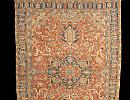Contact Seller
Sharafi And Co
Tel020 8902 0802Please quote Antiques Atlas.


 Antique Baluch Tribal Rug.
Antique Baluch Tribal Rug.
 Antique Afshar Rug.
Antique Afshar Rug.
 Antique Isfahan Rug.
Antique Isfahan Rug.
 Antique Large Kurdish Rug.239CM X 114CM.
Antique Large Kurdish Rug.239CM X 114CM.
 Antique Turkish Kayseri Prayer Rug.171cm X 138cm.
Antique Turkish Kayseri Prayer Rug.171cm X 138cm.
 Antique Bijar Bidjar Tribal Village Rug.224cm X139
Antique Bijar Bidjar Tribal Village Rug.224cm X139
 A Fine Antique Malayer Rug. 204cm x 130cm.
A Fine Antique Malayer Rug. 204cm x 130cm.
 Antique Caucasian Kuba Konagkend Rug.160cm x 131cm
Antique Caucasian Kuba Konagkend Rug.160cm x 131cm
 Rare Antique Tekke Turkmen Flat Weave Kilim Rug.
Rare Antique Tekke Turkmen Flat Weave Kilim Rug.
 An Antique Kerman (kirman) Millefleurs Prayer Rug
An Antique Kerman (kirman) Millefleurs Prayer Rug
 Antique Kurdish Long Rug Kelleh. 291cm x 126cm.
Antique Kurdish Long Rug Kelleh. 291cm x 126cm.
 Rare Antique Safavid Zand Era Tabriz Rug.18thc
Rare Antique Safavid Zand Era Tabriz Rug.18thc
Non UK callers :
+44 20 8902 0802
Antique Qashqai Rug


1 of 3
Lovely antique Qashqai rug. While this piece has very low pile all over and some small restorations, it possesses a lot of charm and beautiful colours.
Qashqai are based in the Fars region which is the land of original Persians. Fars is in the south of Iran. It was the heart of the Achaemenid Empire and an important section of the Sassanian kingdom and indeed it has always been one of the most important regions of Iran through out its history. During the reign of Karim Khan Zand Shiraz was the capital of Iran. Consequently with such rich history comes a very rich culture and art. Two of Iran’s most famous poets Hafiz and Saadi are from Shiraz.
The Qashqais are nomads who are Turkish speaking and were forced to migrate to the province six centuries ago. They get their name from Qashqa which means horse with a white face in Turkish. This is because they used to own a lot of horses with white face. The Qashqais are not one tribe but a confederacy of six tribes, Shesh-Boluki, Kashkuli Bozorg, Kashkuli Kuchek, Dareh-Shuri, Amaleh and Farsimadan. Each Tribe has it’s own migration route and pastures. Also each tribe has many sub-tribes in fact there are 66 sub-tribes.
The nomads trekked twice annually from their warmer winter pastures in the southern lowlands to the cooler summer grounds in the northern highlands.
Shortly after Nowruz Iranian New Year, which coincides with the vernal equinox the migration starts towards the summer pastures. They travel for about six or seven hours a day. This takes about one month. Once settled in the summer pastures the women have plenty of time for weaving. Most of the weddings take place during this time. At the beginning of autumn the tribes start their migration back to the winter pastures.
Young girls and women as part of their chores do weaving. Men are responsible for the security of the tribes and setting up and dismantling tents sale of the tribal products and purchase of the basic commodities for the family in the bazaars of the big towns on the migration route or peddlers who visit the tribe. In the old days the tribes were very self-reliant. They used to obtain wool by shearing the tribes’ own sheep then spun the wool and then dye with vegetable dyes.
Tribal rugs are generally smaller than rugs woven in urban workshops. This is because of the limitations that exist during migration when the loom has to be dismantled rolled round a tent pole and set up again at the next encampment. Obviously this causes some irregularities in the rug, which is part of the charm of these nomadic pieces and considered acceptable whereas it would be considered a fault in an urban rug.
Qashqai rugs are woven with the Turkish knot and they usually have woollen warps and wefts.
SellerSharafi And Co
View all stock from
Sharafi And Co

 Unit 10, Towers Business Park
Unit 10, Towers Business Park
Fourth Way
Wembley
Middlesex
HA9 0LQ
Tel : 020 8902 0802
Non UK callers : +44 20 8902 0802
Get directions to Sharafi And Co
Qashqai are based in the Fars region which is the land of original Persians. Fars is in the south of Iran. It was the heart of the Achaemenid Empire and an important section of the Sassanian kingdom and indeed it has always been one of the most important regions of Iran through out its history. During the reign of Karim Khan Zand Shiraz was the capital of Iran. Consequently with such rich history comes a very rich culture and art. Two of Iran’s most famous poets Hafiz and Saadi are from Shiraz.
The Qashqais are nomads who are Turkish speaking and were forced to migrate to the province six centuries ago. They get their name from Qashqa which means horse with a white face in Turkish. This is because they used to own a lot of horses with white face. The Qashqais are not one tribe but a confederacy of six tribes, Shesh-Boluki, Kashkuli Bozorg, Kashkuli Kuchek, Dareh-Shuri, Amaleh and Farsimadan. Each Tribe has it’s own migration route and pastures. Also each tribe has many sub-tribes in fact there are 66 sub-tribes.
The nomads trekked twice annually from their warmer winter pastures in the southern lowlands to the cooler summer grounds in the northern highlands.
Shortly after Nowruz Iranian New Year, which coincides with the vernal equinox the migration starts towards the summer pastures. They travel for about six or seven hours a day. This takes about one month. Once settled in the summer pastures the women have plenty of time for weaving. Most of the weddings take place during this time. At the beginning of autumn the tribes start their migration back to the winter pastures.
Young girls and women as part of their chores do weaving. Men are responsible for the security of the tribes and setting up and dismantling tents sale of the tribal products and purchase of the basic commodities for the family in the bazaars of the big towns on the migration route or peddlers who visit the tribe. In the old days the tribes were very self-reliant. They used to obtain wool by shearing the tribes’ own sheep then spun the wool and then dye with vegetable dyes.
Tribal rugs are generally smaller than rugs woven in urban workshops. This is because of the limitations that exist during migration when the loom has to be dismantled rolled round a tent pole and set up again at the next encampment. Obviously this causes some irregularities in the rug, which is part of the charm of these nomadic pieces and considered acceptable whereas it would be considered a fault in an urban rug.
Qashqai rugs are woven with the Turkish knot and they usually have woollen warps and wefts.
Price The price has been listed in British Pounds.
Conversion rates as of 27/MAR/2025. Euro & Dollar prices will vary and should only be used as a guide.
Always confirm final price with dealer.
Dimensions207x143cm
Category Antique Carpets and Rugs
Date Circa 1920
1920s Antiques Material Wool
Origin Persian
Condition Overall very low pile and small areas of restoration
Item code as455a009 / M170
Status Sold
£950.00 
$1231.49 
€1140.29 

$

€

Conversion rates as of 27/MAR/2025. Euro & Dollar prices will vary and should only be used as a guide.
Always confirm final price with dealer.
View all stock from
Sharafi And Co

 Unit 10, Towers Business Park
Unit 10, Towers Business ParkFourth Way
Wembley
Middlesex
HA9 0LQ
Tel : 020 8902 0802
Non UK callers : +44 20 8902 0802
Get directions to Sharafi And Co
You may also be interested in
 Antique Baluch Tribal Rug.
Antique Baluch Tribal Rug.
 Antique Afshar Rug.
Antique Afshar Rug.
 Antique Isfahan Rug.
Antique Isfahan Rug.
 Antique Large Kurdish Rug.239CM X 114CM.
Antique Large Kurdish Rug.239CM X 114CM.
 Antique Turkish Kayseri Prayer Rug.171cm X 138cm.
Antique Turkish Kayseri Prayer Rug.171cm X 138cm.
 Antique Bijar Bidjar Tribal Village Rug.224cm X139
Antique Bijar Bidjar Tribal Village Rug.224cm X139
 A Fine Antique Malayer Rug. 204cm x 130cm.
A Fine Antique Malayer Rug. 204cm x 130cm.
 Antique Caucasian Kuba Konagkend Rug.160cm x 131cm
Antique Caucasian Kuba Konagkend Rug.160cm x 131cm
 Rare Antique Tekke Turkmen Flat Weave Kilim Rug.
Rare Antique Tekke Turkmen Flat Weave Kilim Rug.
 An Antique Kerman (kirman) Millefleurs Prayer Rug
An Antique Kerman (kirman) Millefleurs Prayer Rug
 Antique Kurdish Long Rug Kelleh. 291cm x 126cm.
Antique Kurdish Long Rug Kelleh. 291cm x 126cm.
 Rare Antique Safavid Zand Era Tabriz Rug.18thc
Rare Antique Safavid Zand Era Tabriz Rug.18thc




